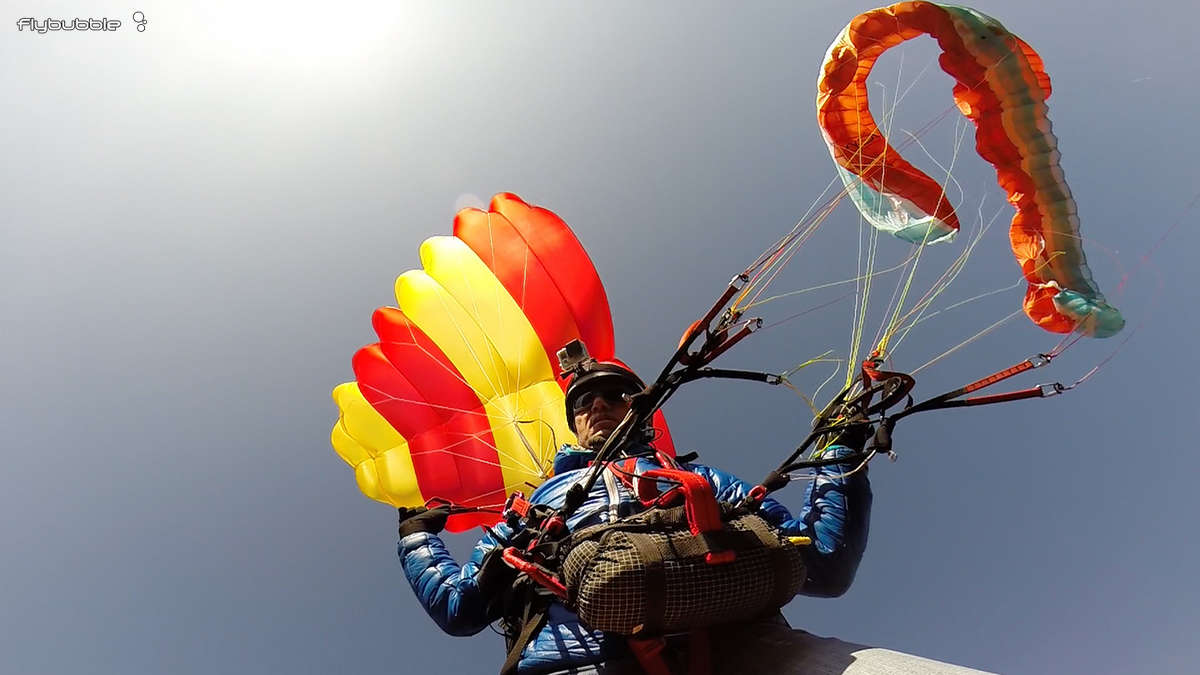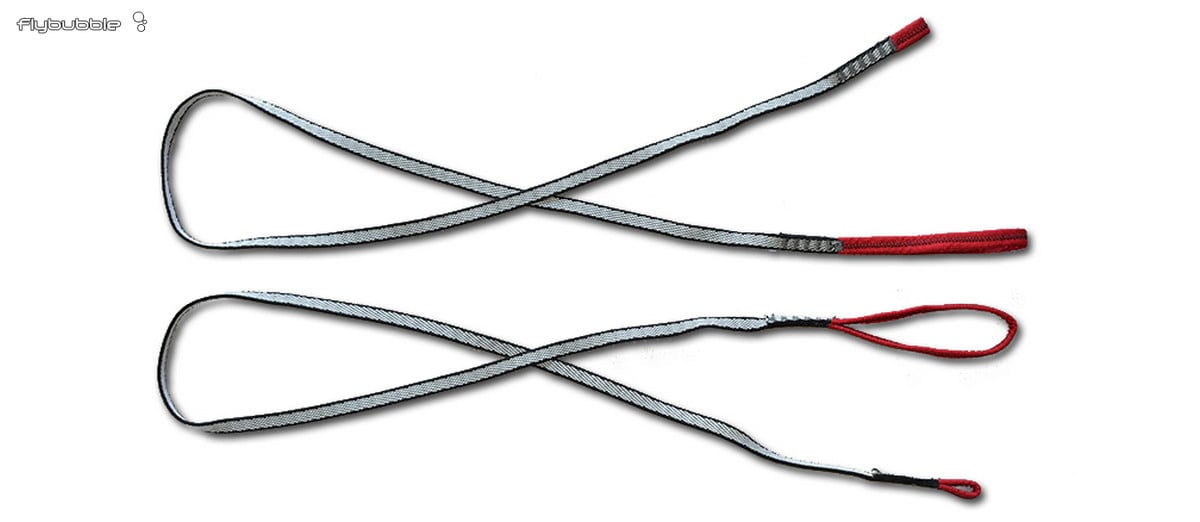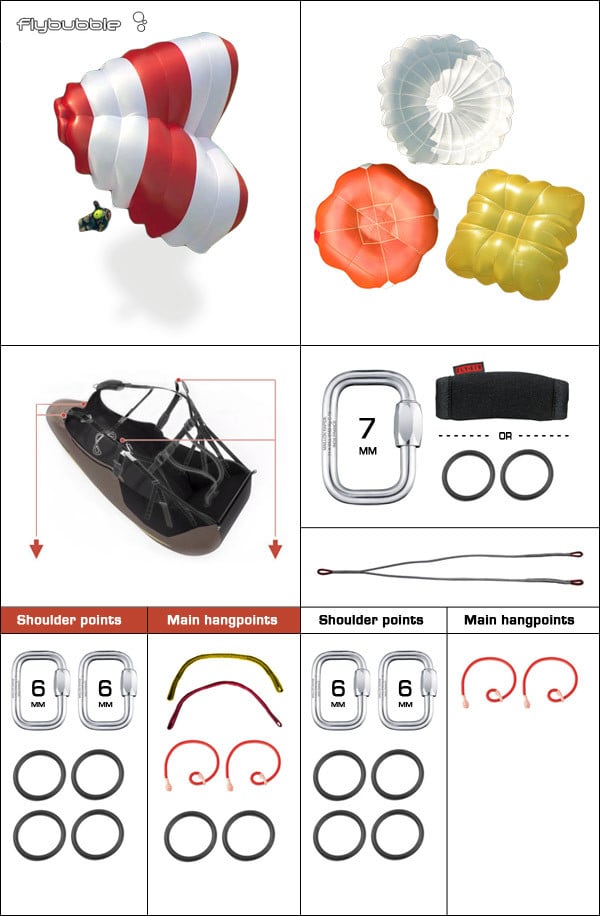
Now that you've chosen your harness and reserve, it's time to choose suitable connectors to connect them! The emergency reserve parachute system may be connected to the harness, the main harness/wing connectors—usually involving a reserve outer container—or the tandem spreaders, depending on the particular whole equipment setup. To help correctly connect the reserve parachute, this article outlines the main considerations for this, and gives a 'connectors shopping list' to help you ensure you have everything you need.
When you buy a reserve parachute it usually terminates in a short webbing loop, known as the reserve strop. This usually needs to be connected to the harness using maillons or soft links and a reserve bridle, each of which you may have to purchase separately. Within some harnesses, the reserve bridle is included and is attached to the top of the shoulder straps, then routed through concealed channels to the reserve container, if it is integral to the harness.

Which reserve bridles?
See our range of reserve bridles
These come in two main formats. One is a single reserve bridle in an inverted Y shape, with two connection points at the top (for connecting to the harness) and one at the bottom (for connecting to the reserve strop), commonly known as Y bridles. The other format is a pair of single reserve bridles, each with single connection points at each end (4 total), commonly known as H bridles (as seen in the see image above).
Reserve bridles are usually made from either webbing or Dyneema. Webbing is cheaper. Dyneema is lighter and stronger. Webbing reserve bridles tend to be wide or extra wide. Dyneema reserve bridles tend to be narrow.
Sometimes reserve bridles are sewn in as part of the harness, in which case the existing webbing to webbing connections on the shoulder points are suitable. If you only have the attachment points but no reserve bridle on your harness, you need to purchase one.
Reserve bridles come in different lengths, which affects the pendular stability of the reserve, so it's best to match the brand of your bridle with the reserve or choose one of similar specifications. It should also be compatible with your harness. The bridle should be attached to both harness shoulder strap loops, not just one of them.
Most reserves come with a short webbing strop connecting the lines together. Steerable reserves have two long bridles. Some older non-steerable designs have long Y bridles sewn in. Do not attach them to a harness reserve bridle as the total length will be too long; connect directly to the shoulder points or main hang points. Steerable reserves also require short extenders when connected on the main hang points, for optimal steering.

No shoulder points?
Some harnesses (usually the ultralight ones) don't come with shoulder attachment points for the reserve bridles. It is unsafe to connect a reserve onto the shoulders if the harness doesn't have specially reinforced support loops there! Use the main hang points instead. You could simply loop the bridles onto the main karabiners, but this offers no safety should your karabiner fail. Dedicated soft links can be run through the main attachment points to connect the reserve bridle instead.
Webbing to webbing?
If you connect the reserve bridle without using a maillon (by passing it through the loop and itself, then pulling tight) you have a webbing-to-webbing connection, and there is a risk of shearing due to heat from friction during shock deployments. This can be mitigated if the attachment points are designed to withstand heat shear, if the same material is used on both sides, and if the connection is secured in position, but most manufacturers recommend connecting reserves using maillons.

Which maillons (or soft links)?
Most manufacturers recommend connecting reserves using maillons, held securely in place by O-rings and maillon covers.
You will need to decide which shape and size of maillon you require, to suit your equipment and the intended use.
We can only recommend maillons made by Peguet Maillon Rapide. Please be careful of cheap copy products which have questionable strength.

Which shape of maillon?
Measure the width of the webbing on both sides of each connection to ensure you get the right style of maillon. Less than 15mm wide is narrow webbing. 15-30mm is wide webbing. 30-40mm is extra wide webbing. For wide to wide webbing use a square maillon. Wide to narrow: delta maillon. Narrow to narrow: standard oval maillon. Extra wide to wide: trapeze maillon. We have stock of all of these maillons so that the most suitable one can be used.

Which size of maillon?
Due to their shape, standard oval maillons are stronger by design than the other shapes: square, delta and trapeze. As a rule of thumb, each size of standard oval maillons is as strong as the next size up of square, delta or trapeze maillon. For example, a 6.0mm standard oval maillons is as strong as a 7.0mm square, delta or trapeze maillon. However, also due to their shape, they are only suitable for narrow to narrow webbing connections.
For the single connection point at the base of the reserve riser, for wide to wide connections we recommend using a Peguet Maillon Rapide Square Stainless Steel 7.0mm maillon. For wide to narrow connections we recommend a Peguet Maillon Rapide Delta Stainless Steel 7.0mm maillon. For narrow to narrow connections we recommend a Peguet Maillon Rapide Standard Oval Stainless Steel 6.0mm maillon.
For the two attachment points on the harness, for wide to wide connections we recommend using two Peguet Maillon Rapide Square Stainless Steel 6.0mm maillons. For wide to narrow connections we recommend using two Peguet Maillon Rapide Delta Stainless Steel 6.0mm maillons. For narrow to narrow connections we recommend using two Peguet Maillon Rapide Standard Oval Stainless Steel 6.0mm maillons.
This is based on recommended industry standards and allows for manufacturing variations and ageing. For paramotor or tandem flying, or more peace of mind, increase the maillon size by 1mm; they really don't cost or weigh much in the grand scheme of things!
Which size of O-ring?
Which size of O-ring is suitable for a connection point depends mostly on the maillon shape (end widths) and size (rod diameter). As a guide:
For 5 and 6 mm standard oval maillons, use 30mm O-rings.
For 5-7mm delta, 5mm rigging, 5-8mm square and 7mm standard oval maillons, use 40mm O-rings.
30mm O-rings can also be used for the narrow end of 5 and 6mm delta and 5mm rigging maillons.
Soft links
Alternatively, if saving every gram is of primary importance to you, suitable soft links can be used at all points. However bear in mind that soft links are much more complex to close than maillons and will likely fail catastrophically if this is done incorrectly. If in doubt, use maillons.

The FFVL recommends there should be protection between the individual parts of the set up. It’s things like this that push the use of soft links into more experienced pilot territory.
Securing the maillons (or soft links)
To avoid the risk of catastrophic failure, maillons and soft links should be properly held in place to prevent heat friction burns on reserve opening.
Maillons should be properly held in place using O-rings and a maillon cover. This also ensures they cannot rotate from their strongest position (lengthwise loading). The maillon should be properly screwed shut to avoid any possibility of it opening accidentally. Finger tight is generally not enough to be sure they won't open over time. Tighten a little using pliers but be careful not to over-tighten as this could damage the thread and greatly weaken the maillon!
Soft links should be properly held in place using a neoprene cover. Follow the manufacturer's instructions carefully to ensure you close them properly. If done incorrectly they will likely fail catastrophically.
Reserve parachute connectors shopping list
|
Reserve is: |
Steerable |
Non-steerable |
||
|
Bridle connector |
None needed |
1 maillon 7mm (or standard oval 6mm) + 2 O-rings + 1 maillon cover or 1 soft link + neoprene cover |
||
|
Bridle |
Has integrated bridle |
Y bridle suited to harness (if bridles not integrated) |
||
|
Harness has: |
Shoulder loops |
Main loops only |
Shoulder loops |
Main loops only |
|
Harness connectors |
2 maillons 6mm |
2 bridle extenders |
2 maillons 6mm |
2 soft links* |
* soft links not strictly necessary, but provides safety in case of main karabiner failure.

Related reading
Choose The Right Reserve Parachute series:
Choose The Right Reserve Parachute — Flybubble
Fitting the reserve parachute — Flybubble
Reserve parachute care & repacking — Flybubble
How To Deploy Your Reserve Parachute — Flybubble
Urs Haari and the Modern Reserve Parachute — Flybubble
Choose The Right Connectors series:
Choose The Right Connectors — Flybubble
Connecting the wing — Flybubble
Connecting the speed system — Flybubble
Choose The Right Equipment series:
Choose The Right Paraglider — Flybubble
Choose The Right Paragliding Harness — Flybubble
Choose The Right Flight Instrument — Flybubble
Brought to you by Flybubble
Like what we do? The best way to support us is to buy gear from us and recommend us to others,thank you!
